Ride1UP LMTD Review, 2024
Ride1Up has a new LMTD out for sale: The LMTD V2. Click here to see that review, as this model is no longer available for sale.
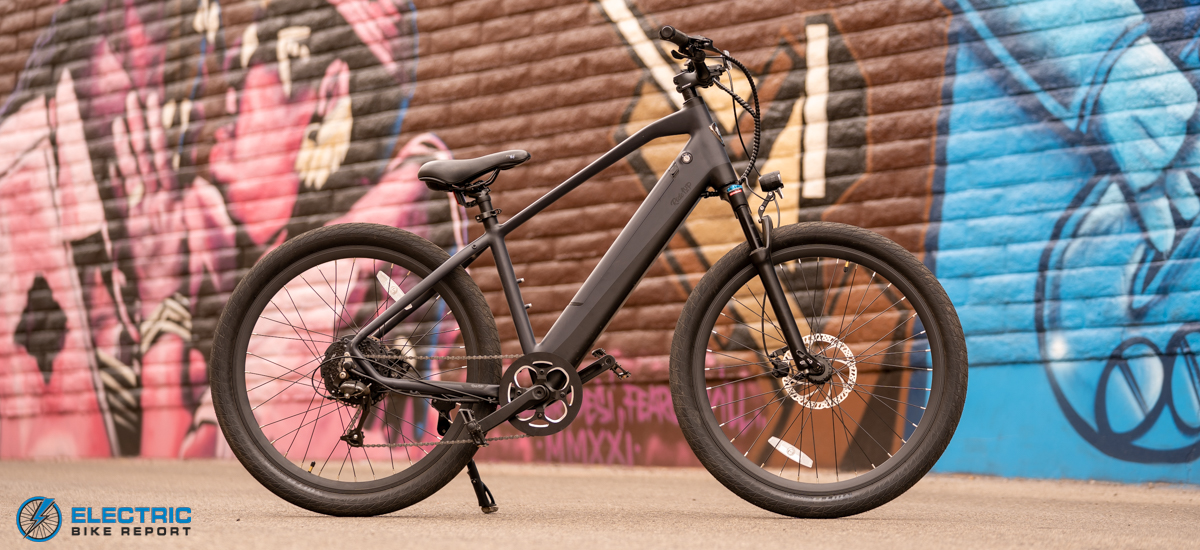
What we will explore in our Ride1UP LMT’D review is how this is an e-bike more focused on performance than function. It’s an affordable muscle car of an e-bike. It features a powerful motor, a sizable battery, a high-quality suspension fork, quick-rolling tires, an 8-speed drivetrain and perhaps most notable is that it uses a torque sensor to control the motor rather than a cadence sensor.
All added up the Ride1UP LMT’d just feels like it’s a performance tier above its price tier which is certainly no small feat to accomplish. To achieve this there were some concessions made by omitting a few standard features, but everything you DO get included adds up to a sensational ride.
For all of our thoughts on the total package on the Ride1UP LMTD head further down into our comprehensive review.
 Pro’s
Pro’s- 750W brushless hub motor is controlled by a torque sensor rather than a cadence sensor to give riders a more natural ride and more proportional assistance
- 672Wh battery can offer 50 mi. of range
- 8-speed Shimano drivetrain not only offers another gear but it gives riders a wider range
- The 80mm-travel air/oil fork provides a more supple ride than coil spring forks do
- The 27.5 x 2.4-in. WTB Groov-e tires have a low-profile tread and roll quickly
- Ride1UP’s claim that the LMT’D could be ridden for up to 50 miles on a single charge proved to be spot-on in our testing
 Con’s
Con’s- Some shoppers will be disappointed that the LMT’D doesn’t include fenders or a rack, but their ommmision to focus on more premium features like the torque sensor and air fork are a trade we’re okay with (and those are easy to add on if needed).
- We typically prefer to see the controller and the display be separate components so the display could be mounted near the stem
- Battery: 672Wh Reention Eel Pro Samsung
- Display: Color LCD
- Motor: 750W brushless, geared hub motor producing 100Nm of torque
- Headlight: 60 Lux light
- Taillights: N/A
- Peal Assist: 5 levels of PAS
- Range: 30-50 mi. depending on rider weight and terrain
- Throttle: thumb button
- Claimed weight: 53 lbs.
- Maximum rider weight: 300 lbs.
- Maximum load on rear rack: N/A
- Brakes: Tektro hydraulic disc brakes with 180mm rotors
- Fenders: N/A
- Fork: Air/oil suspension fork with 80mm of travel
- Frame: 6061 aluminum
- Drivetrain: 8-speed Shimano
- Grips: lock-on, ergonomic rubber
- Saddle: Selle Royal Freeway Plush Gel
- Handlebar: aluminum riser bar
- Kickstand: Included
- Pedals: Included
- Tires: WTB Groov-e 27.5 x 2.4 in.
Ride1UP LMT’D Review: Bike Overview
Rather than include a number of accessories that not every rider wants or needs and can easily be added after the fact, Ride1UP invested in several components that can’t be upgraded very easily. The first, most obvious upgrade over similarly priced bikes is the presence of a Shimano 8-speed drivetrain. Not only does this drivetrain add one gear more than we see with most competitors, the range of gearing is broader, giving it both more high-end and low-end gearing. This gives the Ride1UP LMT’D the ability to climb hills more easily as well as a big enough gear to reach 28 mph.
The second big upgrade can be found in the motor. Not only does the motor produce 750W, it can turn with 100Nm of force, which makes it a very capable climber. However, the biggest difference between the Ride1UP LMT’D and other e-bikes in this price range is that instead of using a cadence sensor to trigger the motor, the LMT’D is built with a torque sensor. A few other models from Ride1UP we’ve reviewed include usage of a torque sensor, and we typically prefer their feel, but we will explain that significance later in this review.
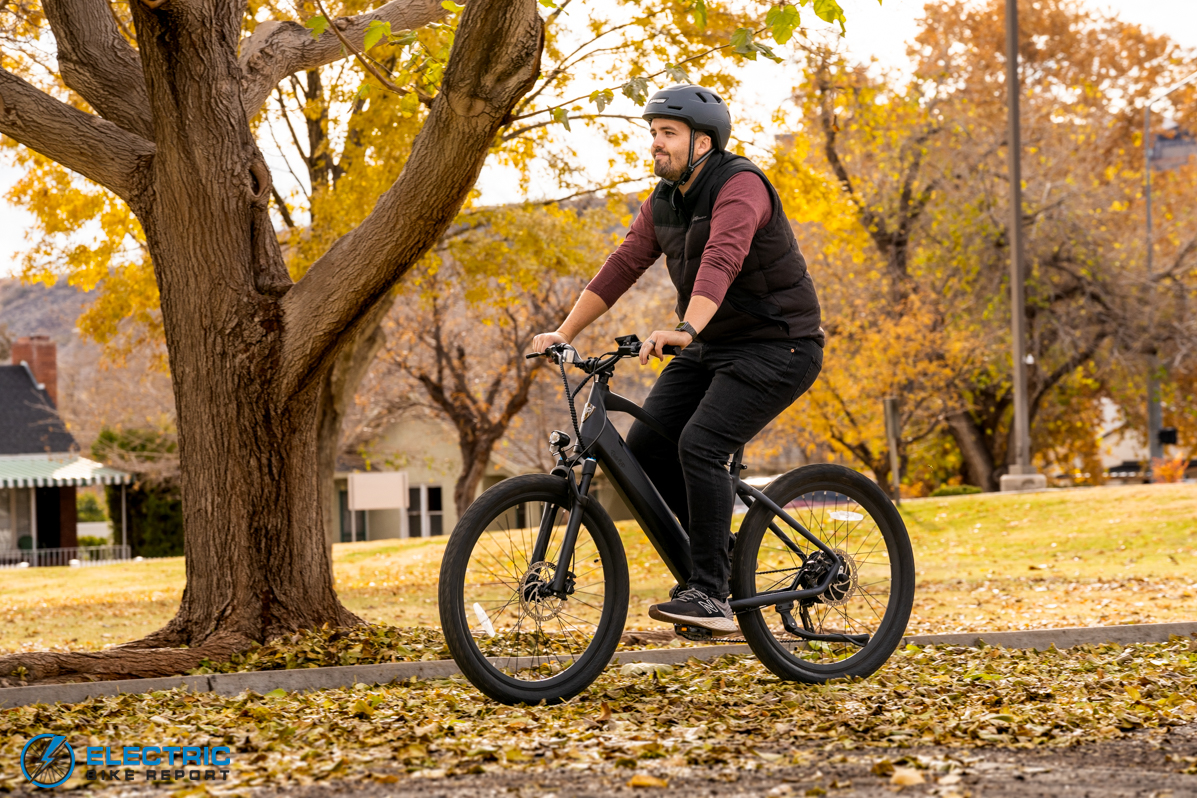
The Ride1UP LMT’D was calm and confident at speed.
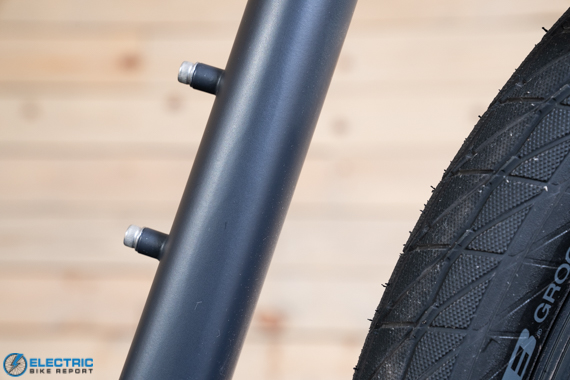
The LMT’D includes braze-ons to mount a water bottle cage.
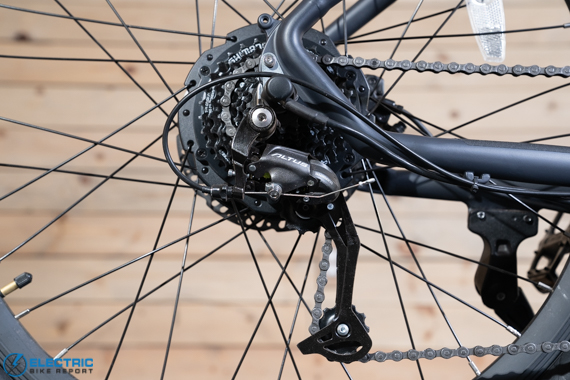
The 8-speed Shimano drivetrain offers a very broad range of gears to get up hills and cruise at Class 3 speeds
Ride1UP LMT’D Review: Motor Performance, Speed and Acceleration

The Ride1UP LMT’D is a Class 3 e-bike intended to satisfy the needs of a rider who wants a higher-performance e-bike at an affordable price. Most e-bikes in the $1500-$2000 price, and even up to $2500 are built as Class 1 or 2 e-bikes with a maximum speed of 20 mph.
For reasons primarily to do with wind resistance, the difference in power necessary to go 28 mph is substantial, which is why the motor spec’d in the Ride1UP LMT’D not only produces 750W, it’s also very torquey and turns with 100Nm of force.
In our circuit test over a 1-mi., four corner loop with a hill that climbs 40 vertical feet, the Ride1UP LMT’D performed admirably. On our first trip around with no assistance, I managed a quite speedy 13.2 mph, which is a good result and shows that there isn’t any significant drag from the motor when it’s off.
At PAS 1, the motor kicked in with obvious gusto, helping us to a 16.2 mph average speed. We see far too many e-bikes where PAS 1 is distinctly underpowered. That was not the case here. Thank the torque sensor for sensing what I was putting down at the pedal level and supplying motor power to match.
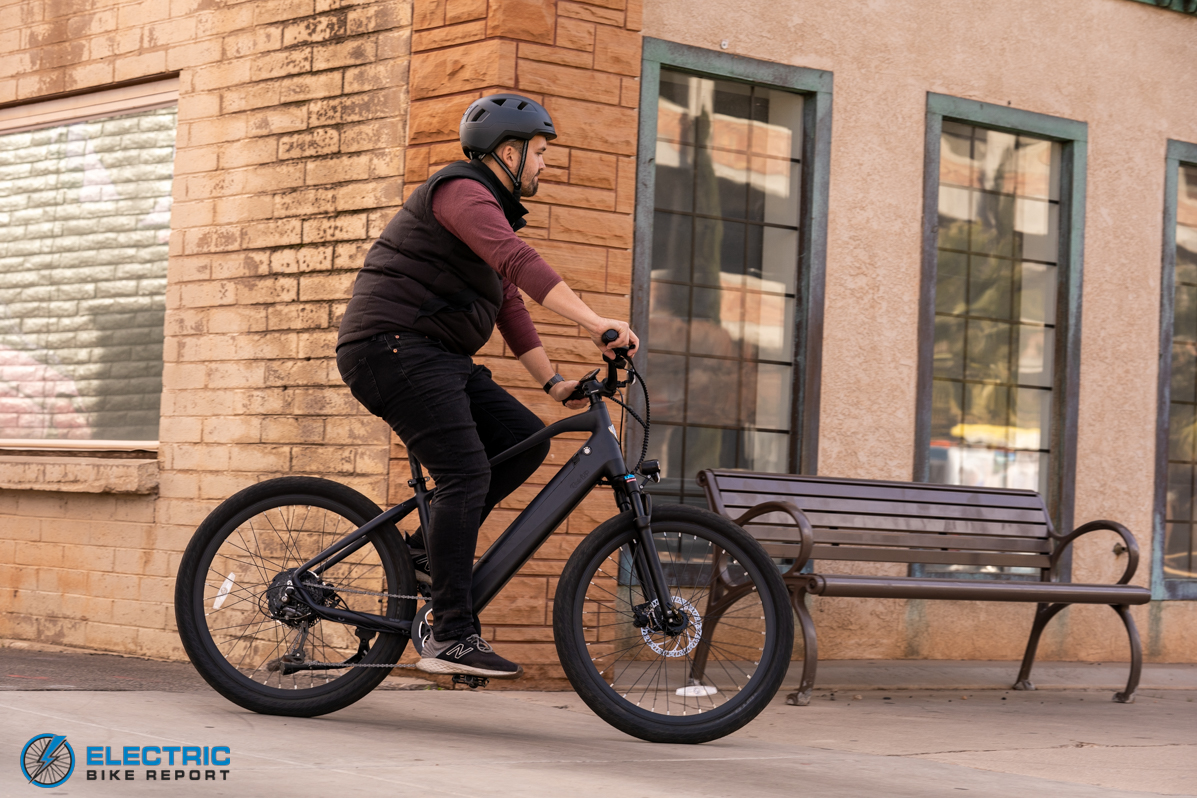
Our crew found the traditional frame to be big enough to offer taller riders a comfortable fit.
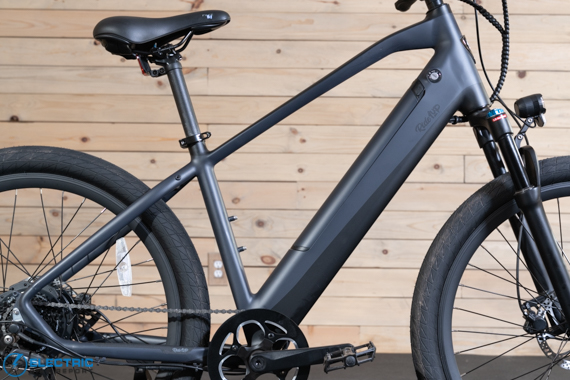
The integrated battery mounts from the top of the down tube rather than from beneath it, making insertion and removal easier
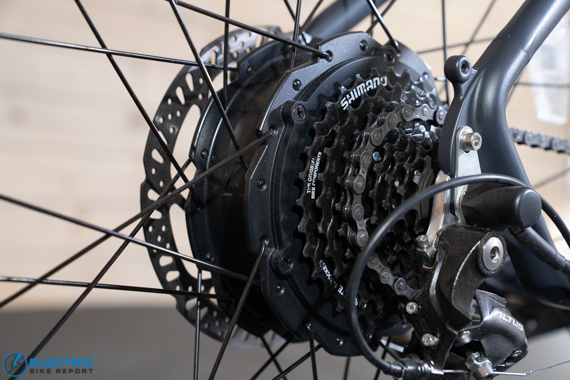
The 750W hub motor impressed us with 100Nm of torque, which made it a very adept climber
From our PAS 1 average of 16.2, each successive lap saw a noticeable increase in assistance and, therefore, average speed.
Some readers will wonder why if this is a Class 3 e-bike why the PAS 5 average speed wasn’t closer to 28 mph. The reason why has to do with the torque sensor. Because torque sensors deliver power in proportion to the rider’s effort, the harder the rider goes, the faster the e-bike goes. For this test, I did each lap of our circuit with as close to the same level of effort as possible, and the level of effort was moderate—not hard by any means, but not soft-pedaling, either.
With a cadence sensor, each PAS level essentially correlates to a specific speed. PAS 3 on one e-bike may be 16 mph and as long as the rider is turning the pedals. With a torque sensor, not only does the motor kick in immediately, not after the better part of a pedal stroke, the response is dynamic, so when a rider softens their pedal stroke as they approach an intersection, the bike will begin to slow even without hitting the brakes. The experience feels more seamless and natural. The experience feels less motorized and more Superman.
Ride1UP LMT’D Review: Range Test & Battery Performance
With a 672Wh Samsung battery, the Ride1UP LMT’D is meant to offer significant range. Ride1UP’s website gives a nod to the way real-world conditions influence just how far a rider might go on a full charge. They suggest that riders may cover anywhere from 30 to 50 mi.
Our test rider covered 51 mi. in PAS 1, for a remarkably spot-on result. In our max PAS test, he still covered an impressive 37 mi., which for a Class 3 e-bike is quite a performance.
One of the reasons the Ride1UP LMT’D was able to achieve such solid range is that the bike itself is remarkably light, all things considered. At 53 lbs., it weighs a good 10-15 lbs. less than many similarly priced e-bikes. That’s less mass to accelerate and less mass to keep at speed. While some riders may be disappointed by the lack of fenders and rear rack, it’s important to bear in mind that they do add some weight to an e-bike.
Ride1UP LMT’D Review: Hill Test
We were especially interested to see how the Ride1UP LMT’D performed on Hell Hole, our ⅓-mi., 12 percent hill that has humbled many an e-bike. With a 750W motor that produces 100Nm of torque, on paper it looked like it should be a solid climber. Our test rider noted that in general, he didn’t need to downshift for most hills.
On our throttle-only ascent, the Ride1UP LMT’D made the climb in 1:34 for an average speed of 11.5 mph. That’s not quick by any stretch, but our other tests are littered with e-bikes that couldn’t finish the hill on throttle alone.
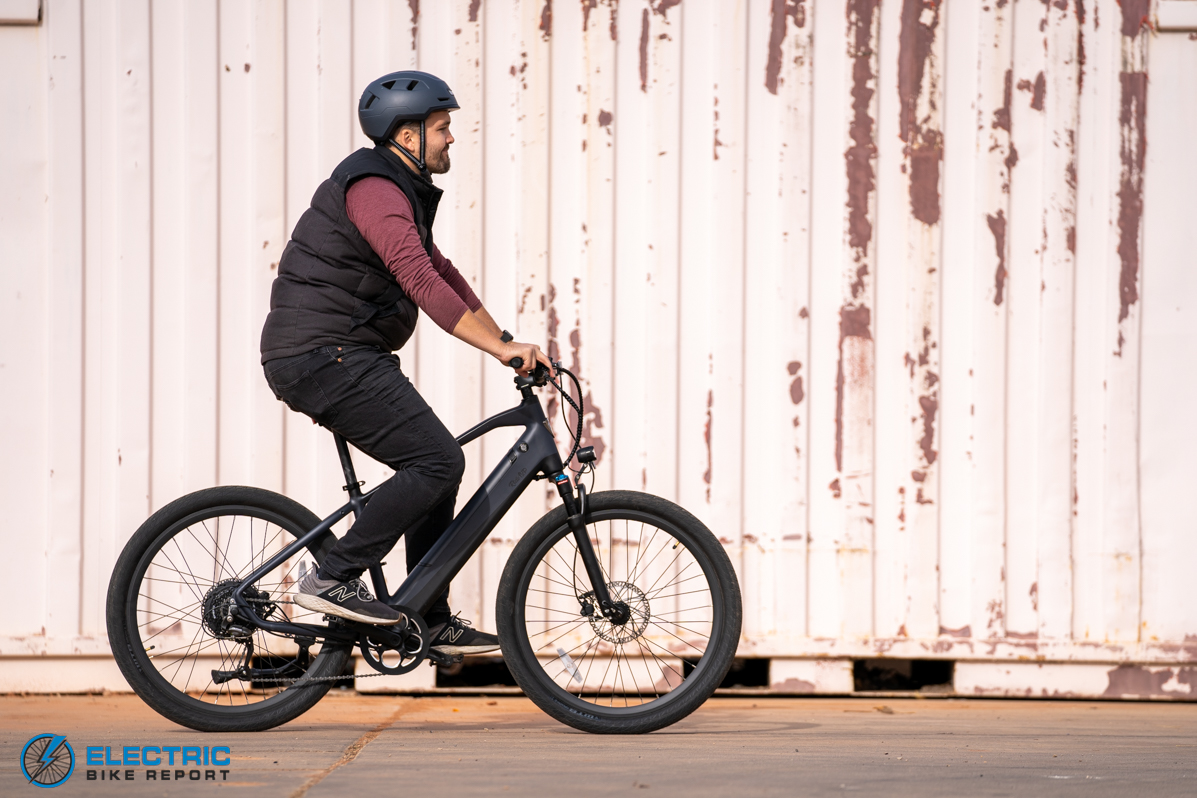
The Ride1UP LMT’D’s theme was a bike that felt a step above the price tag it carried. Good value and performance all around.
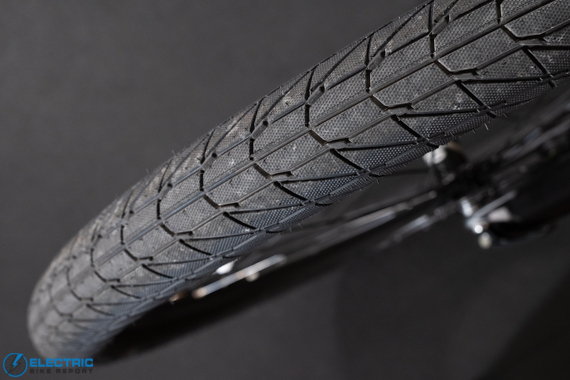
The low profile tread of the 27.5 x 2.4-in. WTB Groov-e tires made for quick and efficient rolling.

The Tektro hydraulic disc brakes were paired with 180mm rotors for excellent stopping power and control.
In PAS 5 the Ride1UP LMT’D sped up the hill in 1:21 for an average speed of 13.4 mph. This result needs a bit of explaining. Our test rider wasn’t pedaling any harder than in other ascents of Hell Hole, but because as we mentioned earlier, a torque sensor applies power in proportion to a rider’s effort, if the rider isn’t pedaling all that hard, the e-bike won’t go all that fast. For that reason, despite the Ride1UP LMT’D being a Class 3 e-bike, the torque sensor didn’t dish out all that much power because our test rider was making the same level of effort as in other tests.
The bottom line here is that considering the rider’s level of effort translates to just how hard the motor works, the 1:21 ascent is quite impressive. The Ride1UP LMT’D is capable of climbing Hell Hole much faster.
Ride1UP LMT’D Review: Safety, Brakes and the Brake Test
Class 3 e-bikes max out their assistance at 28 mph, and compared to 20 mph, 28 really does feel fast, which is a good thing. That sense of speed informs our perspective on how soon to apply the brakes to stop in a reasonable distance. And because 28 mph is about as fast as some riders are comfortable riding, powerful brakes are an important piece of a rider’s confidence in controlling the e-bike.
We recently changed our brake test protocol. Previously, we performed panic stops intended to bring the e-bike to a heel in as short a distance as possible. While the difference in braking performance accurately ranked the e-bikes, the braking distances we achieved did not accurately reflect the distances most riders are likely to see for the simple fact that most of us remain seated and avoid braking hard enough to make the e-bike skid. In our old test our rider would move his weight as far back as possible and brake to the point of locking up the wheels and skidding. The result wasn’t inaccurate, but it didn’t reflect how most people ride.
Considering that change, the 22 ft. 6 in. performance by the Ride1UP LMT’D is a reasonable performance that will give riders a fine sense of control in addition to a reasonable stopping distance. It’s important to remember that most of the time we aren’t in a position of needing to go from 20 mph to a stop; under normal riding conditions we usually slow some by coasting before we hit the brakes.
Ride1UP LMT’D Review: Ride Comfort, Handling and Cockpit
In choosing not to include fenders or a rear rack on the LMT’D, Ride1UP was able offset some of the expense of the higher quality motor, drivetrain and torque sensor, but that doesn’t mean they skimped on rider comfort.
The Ride1UP LMT’D rolls on 27.5 x 2.4-in. WTB Groov-e e-bike-rated tires. While these tires aren’t as wide as the fat tires found on some e-bikes, but they are big enough to offer a nice-quality ride if they aren’t pumped up too high. Worth noting is that these low-profile tires roll more efficiently than a wide, knobby tire and that helps stretch its range much the way its relatively light weight does.
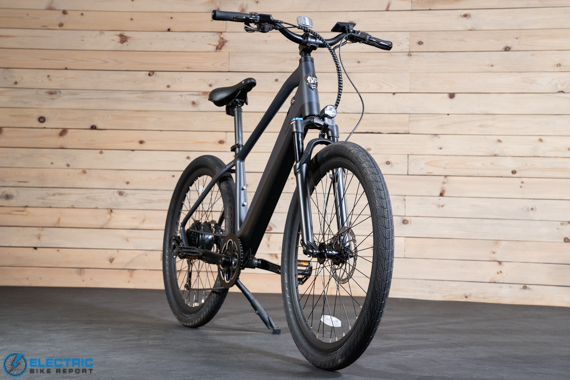
The choice to spec an air/oil suspension fork with 80mm of travel definitely contributed to the comfort of the LMT’D.
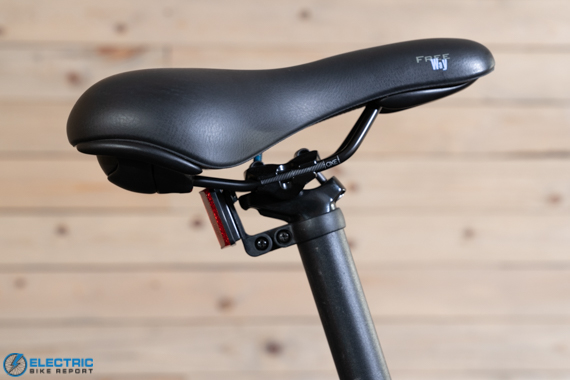
The Selle Royal Freeway Plush Gel saddle wasn’t popular with all of our staff, but it is generally considered a very comfy saddle.
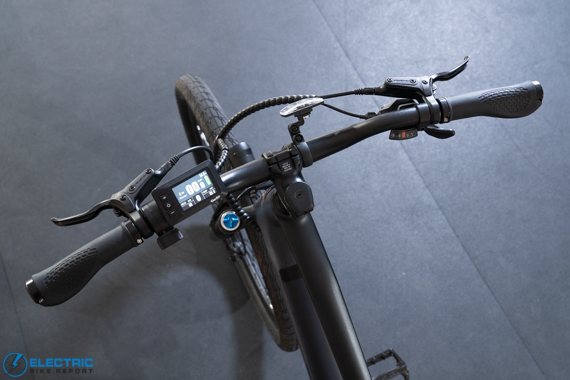
The LMT’D’s handlebar didn’t have much sweep, which helped keep more weight on the front wheel to improve handling.
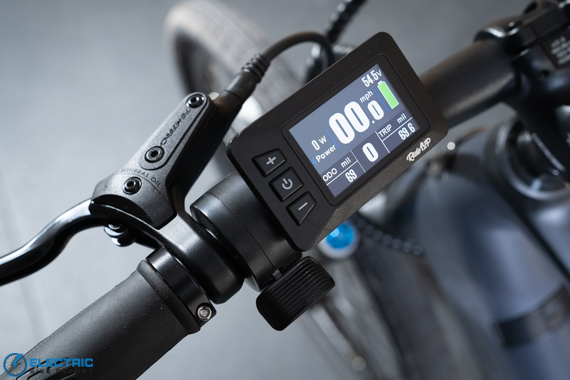
We liked the color display and the easy-to-read battery icon, but would have preferred it sitting closer to the stem. We would also like to see the buttons reached more easily.
The Ride1UP LMT’D also features an air/oil suspension fork with 80mm travel. E-bikes meant for off-road use, particularly eMTBs, will be spec’d with a suspension fork with more travel, often in the range of 120-140mm. That’s not to say that Ride1UP skimped on this fork. With the possible exception of chocolate, there can be too much of a good thing. For e-bikes primarily intended for use on the road and other paved surfaces and only light use on unpaved roads and trails, 80mm is plenty of travel because the bumps most riders will encounter, like driveway lips, aren’t big enough to justify so much travel.
Many of the suspension forks we see in this price range are constructed with a coil spring made from steel. While they work reasonably well, they don’t offer the smooth ride and tunability that air/oil forks provide. In the early part of their travel they tend to be more sensitive and do a better job of making a road feel glassy.
Adding to the comfort package is the Selle Royal gel-filled saddle. Saddle preference is distinctly personal and depends not so much on looks or construction but on the shape of one’s caboose. Someone with a bubble butt may love a saddle that a person with a less junked trunk may think is a torture device. Our test rider didn’t find the Selle Royal saddle to be very comfortable, so while reporting that is our duty, we are aware that this is a very popular saddle that many people ride comfortably.
The handling on the Ride1UP LMT’D is steady and confidence-inspiring. It may not be as nimble at slower speeds as an e-bike with 20-in. wheels, but it remains calm and graceful at 28 mph. That sort of character is an important part of making a Class 3 e-bike worthwhile.
The rider position on the Ride1UP LMT’D is more commuter than cruiser. The handlebar has a bit of sweep and rise to it, though less than we usually see with commuters. The display is mounted on the handlebar near the grip because the buttons are integrated into the display, rather than being a separate component mounted on the bar. We aren’t wild about this configuration because it means the rider has to look toward their left hand to see the display. It’s easier to see a display if it is mounted near the stem and our bodies tend to follow where our head is pointed, so keeping the display in line with the direction of travel is smart.
Ride1UP makes the LMT’D in two different frame designs, one traditional and one in step-thru. Unlike we have seen with some e-bikes where the fit is identical between the two frames, with the LMT’D the step-thru design has a much shorter reach, making it truly appropriate to smaller riders. Kudos to them for making the two frames truly different in size.
Ride1UP LMT’D Review: Summary / Where to Buy
Price-point bikes, like those in the affordable price range face an inherent challenge. Manufacturers want to provide the best collection of features possible, but if they include too many premium features the price must increase. Just which premium parts an e-bike company chooses will tell a shopper much about what their priorities are.
We might compare the typical affordable commuter e-bike to a Toyota Corolla. Functional, affordable, but not exactly sexy. The Ride1UP LMT’D would be more comparable to the Mazda 3—zippy, fun, affordable, even if it’s light on trunk space. And that’s the thing about being on a budget; we must choose our priorities carefully.
In terms of premium features on a budget, we think Ride1UP did a great job on the LMT’D. The motor offers plenty of power and is good on hills. The battery offers terrific range without weighing 10 lbs. The suspension fork has an appropriate length of travel and features a smoother operating air/oil design. The 8-speed Shimano drivetrain means that riders can pedal at 28 mph without turning their legs like the Road Runner. Our favorite feature of this bike might be the torque sensor, though.
It can be difficult to convey to someone who has never ridden an e-bike with a torque sensor just how much a torque sensor improves the ride quality over a cadence sensor. Again, not only does the motor respond immediately, rather than after the better part of a pedal stroke, it responds in proportion to the rider’s effort. If the rider goes easy, the motor goes easy and if the rider goes hard, well the motor kicks into high gear.
Few e-bikes approach perfection much the way it’s hard to find a car that handles like a Ferrari, accelerates like a muscle car, gets the gas mileage of a Prius and has the carrying capacity of a Suburban. Perfection is a pipe dream, but considering the price point Ride1UP targeted with the LMT’D, they produced a very compelling e-bike.
One of the few knocks of this e-bike is the lack of standard fenders and racks, and the display ties in with the controller buttons. We like that it is color. However, we think the buttons should be on a separate component that is easier to reach from the handlebar and the display needs to be mounted near the stem—in line with the direction of travel.
Finding an e-bike that is sold in both a traditional frame and a step-thru design is easy enough to do. What is considerably harder to do is find an e-bike where the reach to the handlebar varies by more than an inch or two. There’s a 4-in. difference in reach between these two bikes, which allows Ride1UP to make a reasonable claim that the LMT’D will fit as broad a cross-section of riders as they say on their website.
The Ride1UP LMT’D is one of the more interesting e-bikes in the affordable price range. For someone who places the ride experience ahead of utility, the LMT’D is a very compelling e-bike. The combination of solid range, a powerful motor and a torque sensor governing the motor makes for one of the most capable e-bikes we have encountered in this price range. This is just the sort of e-bike that we would mention if a friend asked what e-bikes they should consider.
‘Happy Riding, make sure to let us know if you have any questions down in our comments section or if you think we left anything out in this review of the Ride1UP LMT’D.



(1) 5-speed, 7-speed, 9-speed? I don’t particularly care on an ebike, but what really matters in my opinion is the gear range. For example, a lot of 7-speed ebikes come with a 14-28 freewheel, giving a 2:1 range. I immediately replaced mine with an 11-34, which ups the range to 3.1, making a huge improvement on both ends.
(2) Do many folks really ride without fenders or a rack? I can remember as a kid the mudstripe up my back from going through puddles.
(3) It adds little to say a hub motor is “750 watts.” That’s generally regarded as a continuous rating. What matters more to me is “peak power” because that tells us the level of acceleration and hill-climbing ability. My ebike has a 500W motor but consumes about 800W (48v@18a) at maximum chat (British term), or about 1HP.
Incidentally, my ebike needs about 400W (~8 amps) to cruise at 20mph
Looks like they added fenders.
Nice! Happy to see that.
Due in large part to your great reviews, I have recently ordered 2 LMT’d bikes for my wife and I. Being a long time cyclist I have already started looking at upgrades starting with the fork. As I dont have them yet, I cant tell for sure but am trying to verify if it uses a straight or a tapered steerer tube and am finding conflicting answers. Can you confirm that?
Hi Donald, thanks for the question! Assuming you ordered the LMT’D V2, it should have a tapered steerer tube. That model uses the XCM 32 ATB fork from SR Suntour, and you can see the steerer tube on the company’s website.